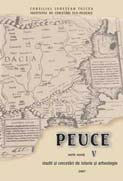Date noi privind descoperiri monetare romane imperiale din Dobrogea
New Data Concerning Roman Republican Monetary Discoveries from Dobrudja
Author(s): Gabriel Mircea TalmaţchiSubject(s): Archaeology
Published by: Institutul de Cercetari Eco-Muzeale Tulcea - Institutul de Istorie si Arheologie
Keywords: Dobrogea; numismatică; epoca romană; Dobrudja; coinage; Roman Age
Summary/Abstract: The author presents a consistent batch composed of 333 coins, made of silver and bronze, issued in the period of the 1st – 3rd centuries AD in Rome, discovered on the territory of Dobrudja. The way in which they were discovered is many times uncertain. Nonetheless, these monetary pieces cover most of Dobrudja, if we look at the northern half or the southern half, or the Pontic coastal line, of the centre of the region and, last but not least, of the right Danubian bank. Each coin is a piece of a monetary mosaic characteristic to the Roman world from the analyzed chronological interval, both if we study their rural and their urban cultural impact. Among the discoveries, the ones appearing in the graves stand out, graves of incineration and of inhumation. These are analyzed by the author on different research levels, regarding the nominal, the significance, the impact on the local communities etc. Most of these funerary monetary discoveries have been made 40-50 years ago (chiefly in Tomis), and it is one of the merits of the author to have introduced them into the scientific circulation with their characteristic significance. Then more recent discoveries from the vicinity of important Dobrudjan centres, like Halmyris, Troesmis, Tropaeum Traiani, Capidava, Tomis, Callatis, Carsium, Noviodunum, Dinogetia or from the vicinity of Roman rural settlements that are already known in the specialized bibliography or are unpublished. Also, the author makes a series of comments and comparisons between what regards the rural monetary circulation and the urban one, by emphasizing the differences that exist but also the common parts. Last, but not least, the author points out that the research of the monetary circulation problem in the Dobrudjan province in the course of the first three centuries after Christ remains open. What we have intended was mainly to make an important “completion” from the quantitative and qualitative point of view, of an already large dossier, and the possible closing points, given the situation, are only provisional.
Journal: Peuce (Serie Nouă) - Studii şi cercetari de istorie şi arheologie
- Issue Year: III/2005
- Issue No: 3-4
- Page Range: 331-374
- Page Count: 44
- Language: Romanian

